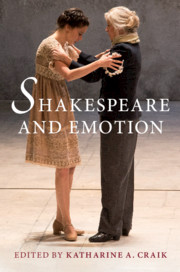Book contents
- Shakespeare and Emotion
- Shakespeare and Emotion
- Copyright page
- Contents
- Figures
- Contributors
- Acknowledgements
- Note on Text
- Introduction
- Part I Contexts
- Chapter 1 Rhetoric
- Chapter 2 Medicine
- Chapter 3 Religion
- Chapter 4 Character
- Chapter 5 Inheritance and Innovation
- Chapter 6 Communities
- Chapter 7 Audiences
- Chapter 8 Acting
- Chapter 9 Bollywood
- Chapter 10 Language
- Chapter 11 Emotional Labour
- Chapter 12 Passionate Shakespeare
- Part II Emotions
- Bibliography
- Index
Chapter 10 - Language
Macbeth, King Lear
from Part I - Contexts
Published online by Cambridge University Press: 01 October 2020
- Shakespeare and Emotion
- Shakespeare and Emotion
- Copyright page
- Contents
- Figures
- Contributors
- Acknowledgements
- Note on Text
- Introduction
- Part I Contexts
- Chapter 1 Rhetoric
- Chapter 2 Medicine
- Chapter 3 Religion
- Chapter 4 Character
- Chapter 5 Inheritance and Innovation
- Chapter 6 Communities
- Chapter 7 Audiences
- Chapter 8 Acting
- Chapter 9 Bollywood
- Chapter 10 Language
- Chapter 11 Emotional Labour
- Chapter 12 Passionate Shakespeare
- Part II Emotions
- Bibliography
- Index
Summary
This chapter tests the claim made by Peter Brook: that through the live practice of drama, the work of Shakespeare offers ‘the greatest school of living’ that we know. Using the resources of philosophy, psychology and neuroscience, it tries to show how the sudden, deep language of Shakespeare, in particular in Macbeth and King Lear, dramatically discloses lost and neglected forms of being, in a primary emotional aliveness that is denied or tamed within more conventional world-orders. Where other writers give us only secondary versions or paraphrases of nature, Shakespeare, said Hazlitt, offers ‘the original text’ of life.
- Type
- Chapter
- Information
- Shakespeare and Emotion , pp. 151 - 166Publisher: Cambridge University PressPrint publication year: 2020

